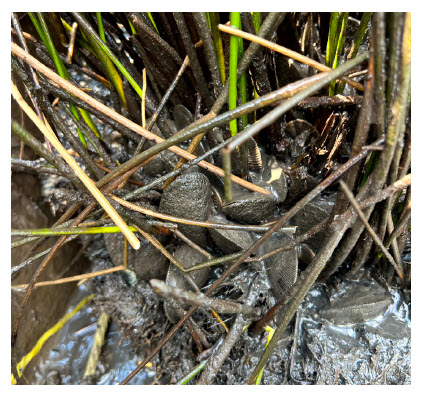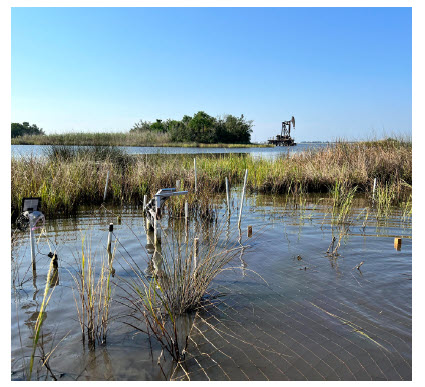Bioremediation and Phytoremediation of an Oil-Contaminated Salt Marsh in South Louisiana
By Lance W. Fontenot, Ph.D., PWS, Senior Consultant
Michele Abbene, Project Scientist
Other contributors: Coklin Nguyen (coklin.nguyen@encos.net) (ENCOS, Inc., Baton Rouge, LA, USA), Chris Sanfilippo (CSanfilippo@txpetinv.com) (Texas Petroleum Investment Co., Lafayette, LA, USA)
Introduction
Traditional remediation methods for oil-contaminated soils (e.g., excavation and backfilling) can cause more harm than benefit in the fragmented coastal wetland system of south Louisiana. Bioremediation and phytoremediation methods present an opportunity for a nondestructive approach to achieving cleanup and restoring critical coastal habitat. Bioremediation involves the addition of materials (e.g., nutrients, bacteria, or other growth-enhancing co-substrates) to accelerate natural biodegradation processes. It is recognized as one of the least intrusive methods for oil remediation in sensitive coastal wetlands (Zhu et al. 2004). Phytoremediation uses natural plant processes to optimize cleanup. Success of bioremediation is contingent upon the ability to establish and maintain conditions that are favorable for the degradation of oil, including temperature, nutrients, oxygen, pH, and salinity (Zhu et al. 2004). Although oxygen is often the primary limiting factor in oil biodegradation, nutrient availability can be a key factor, especially if the oil does not penetrate deeply into anoxic sediments. Phytoremediation and particularly rhizodegradation can provide a mechanism to oxygenate deeper soil intervals and enhance anaerobic metabolism through the increased activity of sulfate-reducing bacteria populations (Cagle et al. 2020).
The study site is located in southwestern coastal Louisiana and was used for tank storage. Currently, remnants of a berm and two distinct unvegetated ponded areas are present within a narrow strip of salt marsh surrounded by open water. Previous investigations indicated elevated oil and grease concentrations (> 1 percent) in soil within the tank areas.
Approach/Activities
The major steps for a bioremediation plan for oil degradation in a salt marsh (Zhu et al. 2004) are pre-treatment assessment, treatment design, monitoring, and assessment of treatment efficacy and treatment endpoints. The pre-treatment assessment of marsh soil indicated the presence of anoxic conditions, a circumneutral pH, and the need for fertilizer application to reach target nitrogen concentrations of 2 to 10 mg/L in porewater for optimal oil biodegradation (Zhu et al. 2004). Treatment design included the selection of rate-limiting agents (nutrients, plants, oxygen, and surfactants), identification of application strategies optimized for the salt marsh, and development of a planting strategy for denuded areas. Treatment parameters monitored semiannually included porewater nutrient and sulfide levels and field measurements of pH, redox, and dissolved oxygen. Visual observations of sheen were used as an indicator of treatment efficacy, and soil sampling for petroleum hydrocarbons to meet regulatory endpoints will be conducted when oil is no longer observed.

This mussel-spartina association binds the root mat together, fortifying against erosion, oxygenating sediments, and providing nitrogen wastes to the roots (Bertness 1984).
The proof-of-concept treatment area was approximately 0.5 acre across four treatment plots (West Pond, West Marsh, East Pond, and East Marsh). Unvegetated ponded areas, with less than 5 percent vegetation cover and experiencing excessive erosion, were the preliminary targets for bioremediation. Drone imagery was used to remotely assess vegetation coverage and conditions to assist with field planning. The surrounding area is heavily vegetated and dominated by smooth cordgrass (Spartina alterniflora), black needlerush (Juncus roemerianus), and leafy three-square bulrush (Bolboschoenus robustus), which are typical plant species of a salt marsh. Atlantic ribbed mussels (Geukensia demissa) were observed associated with the basal stems and roots of S. alterniflora. The primary soil type is silty clay, which limits fertilizer and oxygen dispersal. Plant root depths are approximately 10 in., a depth encountering the hydrocarbons.
Proof of Concept Treatment
Slow-release fertilizer was applied at a depth of 2 ft using a syringe device constructed of acetate or PVC liner tubes and a dibble bar, with spacing approximately 2 ft apart for the ponded, unvegetated areas and 5 ft for the vegetated areas. To achieve a target porewater concentration range of 2 to 10 mg N/L, fertilizer was applied at a rate of approximately 23 lb per 1,000 ft2. During the initial application, approximately 880 probe holes were installed over the treatment area. Approximately 1,350 lb of fertilizer have been applied to date.
Recent laboratory results for porewater indicate that total nitrogen concentrations in three of the four plots met the target range. Ammonia was the only detected form of nitrogen. These results indicate that the fertilizer treatment has increased nitrogen to the target levels, providing sufficient nutrients for initial microbial degradation and facilitating marsh plant establishment and growth, phytoremediation, and coverage of denuded areas.

Twine-mesh grids supported S. alterniflora transplants in ponded areas. The plot soils are aerated by fertilizer application PVC tubes and solar-powered aeration pumps.
Increased phytoremediation potential was accomplished by planting more than 300 plugs of S. alterniflora within the denuded areas. Establishment of marsh vegetation will enhance the bioremediation process in surface soil because the microorganisms associated with the plant rhizosphere are the primary mechanism for the degradation of petroleum hydrocarbons (Hoang et al. 2021). Deep, standing water and several feet of fluffy, unconsolidated soil required unique approaches for transplanting, the most effective being twine-mesh grids staked out to hold the transplants upright until they became established. Surviving plants and transplants maintained approximately 30 percent cover in previously open water areas (West Pond and East Pond). Assuming adequate transplant survival, low erosional conditions, and continued applications of fertilizer, it is anticipated that these plants will increase cover in the denuded areas, promoting contaminant rhizodegradation.
Coastal wetland soils are saturated or flooded, thereby limiting oxygen diffusion rates. In most cases, there is a thin layer of oxidized soil, below which the soil becomes anoxic. Because of this, oxygen availability can be a limiting factor for oil degradation. Although sulfate reduction is an important process for oil degradation when oxygen is limiting, aerobic metabolism degrades oil faster. Methods used to increase oxygen penetration into deeper anoxic soil included the installation of probe holes during fertilizer applications and the placement of slotted PVC pipe connected to aeration pumps 2 ft deep and horizontally along the mudline.
Food-grade surfactants, lecithin and polysorbate-80, were applied topically with a pump sprayer to the East Pond and West Pond and to visually oiled areas adjacent to the ponds. The applications appeared to be effective but were hindered by the flooded conditions, which prevented direct contact with oiled soils. The objective was to enhance the emulsification of the heavy oils to smaller fractions that are more amenable to bacterial degradation (Athas et al. 2014). Soy-based lecithin also provides nutrients that can accelerate bacterial activity (Nyankson et al. 2015).
Results/Lessons Learned
Working in a dynamic, tidally influenced, salt marsh environment with anoxic soil conditions requires continuous adaptive management. This has included trial applications of solar-powered aeration pumps to increase oxygenation and nontoxic dispersants to break up sheens for more effective biodegradation. Based on previous studies and field indicators of treatment efficacy, vegetative transplantation combined with fertilizer application appear to be the most effective methods that act together to simultaneously restore oil-contaminated wetlands and accelerate oil degradation in soil. Over time, establishment of marsh plants in these areas will reduce erosion, increase retention of sediments, and minimize tidal flooding in the treatment area. Reducing flood occurrence will enhance oxygenation of the surface soil.
Nutrient levels have increased over baseline conditions, with target nitrogen concentrations for initial microbial degradation exceeded prior to planting. The increased nitrogen has also facilitated new marsh plant growth, enhancing phytoremediation and coverage of denuded areas. A transplant survival rate of more than 80 percent has been observed to date. However, sheens are still visible in the ponded areas. Additional planting, fertilizer applications, and installation of aeration pumps are planned to address the ponded areas.
References
Athas, J.C., K. Jun, C. McCafferty, O. Owoseni, V.T. John, and S.R. Raghavan. 2014. An effective dispersant for oil spills based on food-grade amphiphiles. Langmuir 30:9285−9294. doi.org/10.1021/la502312n
Cagle, G., Q. Lin, S.A. Graham, I. Mendelssohn, et al. 2020. Planting Spartina alterniflora in a salt marsh denuded of vegetation by an oil spill induces a rapid response in the soil microbial community. Ecol. Eng. doi.org/10.1016/j.ecoleng.2020.105815
Bertness, M.D. 1984. Ribbed mussels and Spartina alterniflora production in a New England salt marsh. Ecology 65(6):1794–1807. doi.org/10.2307/1937776
Hoang, S.A., D. Lamb, B. Sheshadri, B. Sarkar, et al. 2021. Rhizoremediation as a green technology for the remediation of petroleum hydrocarbon-contaminated soils. J. Hazard. Mater. doi.org/10.1016/j.jhazmat.2020.123282
Nyankson, E., M.J. DeCuir, and R.B. Gupta. 2015. Soybean lecithin as a dispersant for crude oil spills. ACS Sustainable Chem. Eng. 3:920-931. doi.org/10.1021/acssuschemeng.5b00027
Zhu, X., A.D. Venosa, T.S. Makram, and K. Lee. 2004. Guidelines for the bioremediation of oil-contaminated salt marshes. EPA/600/R-04/074. US Environmental Protection Agency, Cincinnati, OH


